Comprehensive Report: Nonmedicinal Performance Stimulants in Education
VerifiedAdded on 2020/05/04
|10
|2270
|130
Report
AI Summary
This report examines the non-medical use of stimulants by university students to enhance academic performance. It analyzes two research articles: "Life context of pharmacological academic performance enhancement among university students" by Hildt & Franke, and "The relationship between nonmedical use of prescription stimulants, executive functioning and academic outcomes" by Munro et al. The report explores students' motivations, experiences, and the impact of stimulant use on their academic lives, considering factors like pressure to perform and the balance between studying and leisure. It also discusses barriers to applying evidence in practice, such as the prevalence of stimulant use and the sources from which students obtain these drugs, often from peers. The report concludes by emphasizing the need for comprehensive plans to reduce nonmedical prescription stimulant usage, including dispelling myths, encouraging new research, and disseminating accurate information to identify and mitigate associated risks. The PICO question is also addressed, revealing that the studies do not definitively confirm whether stimulants enhance academic performance, but highlight the relationship between NMUPS and EF.
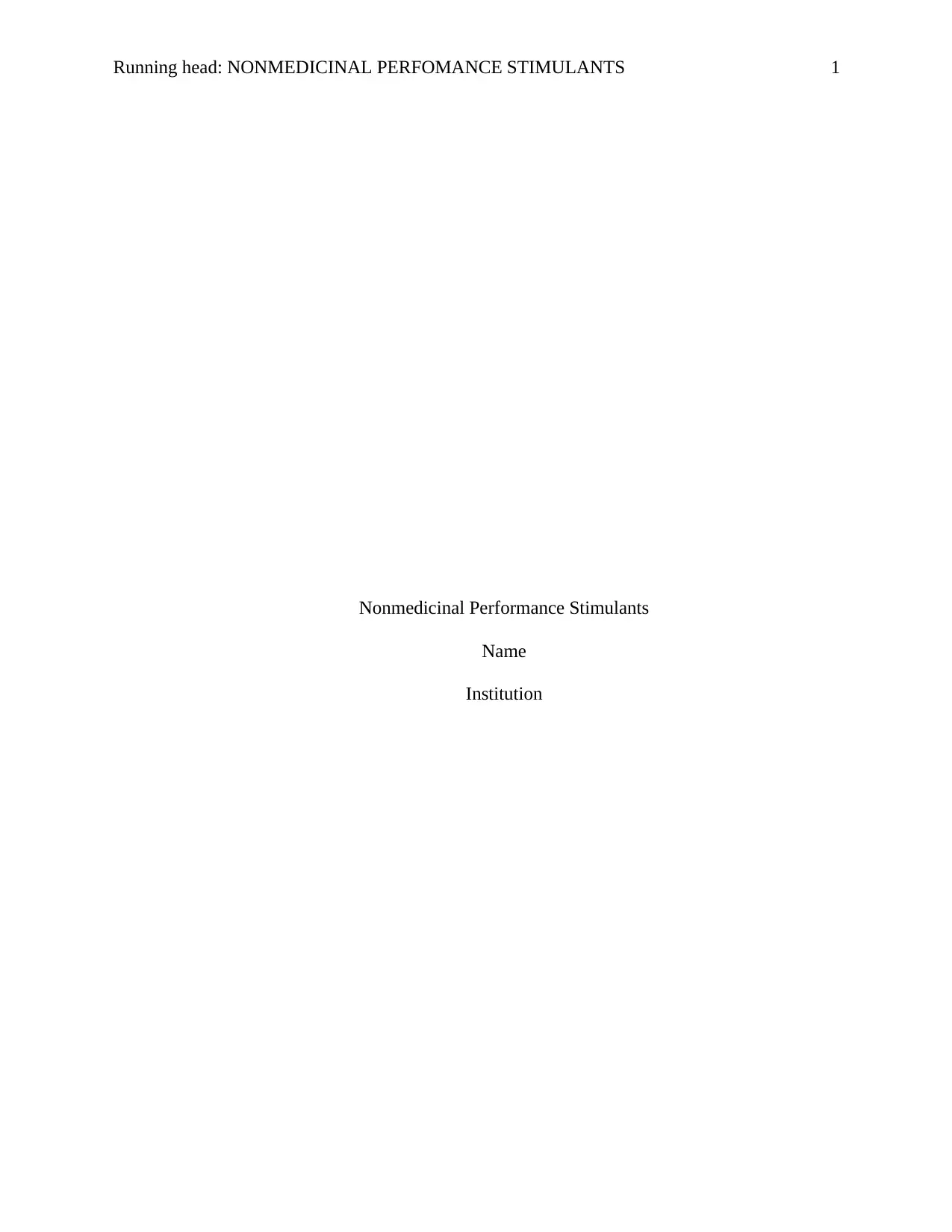
Running head: NONMEDICINAL PERFOMANCE STIMULANTS 1
Nonmedicinal Performance Stimulants
Name
Institution
Nonmedicinal Performance Stimulants
Name
Institution
Paraphrase This Document
Need a fresh take? Get an instant paraphrase of this document with our AI Paraphraser

NONMEDICINAL PERFORMANCE STIMULANTS 2
Nonmedicinal Performance Stimulants
Do stimulants increase academic performance among university students?
The issue of non-medical utilization of stimulants for exclusive academic performance
improvement purpose is virally being a popular practice between university and college learners.
Recent publications and research findings have pointed out that these drugs are technically
highly available on campus and the drugs are particularly sought out by students who struggle
academically. The problem, however, is far from solved, the reduction of nonmedical use of
drugs in university requires particular attention to other third-party variables like heavy drinking
and the possible involvement in another drug abuse. Also, at the national level, the prescription
drugs for non-medical purposes is becoming a more significant aspect pf illegal drug utilization
cases among college students (Singh, Bard & Jackson, 2014). In relation, the paper is a
comprehensive review whose primary objective is to gain an in-depth understanding the
intention of learners to utilize stimulant medication to enhance academic achievement (Ponnet, et
al., 2015). The case study is analyzed from the perspective of Wasim who is a 29-year-old male
Arts student at one of the Australian Universities. The main points of the paper will be examined
through an analysis of two research articles: “Life context of pharmacological academic
performance enhancement among university students by Hildt &Franke and the relationship
between nonmedical use of prescription stimulants, executive functioning and academic
outcomes by Munro, et al., 2017”.
Part A:
Hildt, Lieb & Franke (2014)
Authorship
Nonmedicinal Performance Stimulants
Do stimulants increase academic performance among university students?
The issue of non-medical utilization of stimulants for exclusive academic performance
improvement purpose is virally being a popular practice between university and college learners.
Recent publications and research findings have pointed out that these drugs are technically
highly available on campus and the drugs are particularly sought out by students who struggle
academically. The problem, however, is far from solved, the reduction of nonmedical use of
drugs in university requires particular attention to other third-party variables like heavy drinking
and the possible involvement in another drug abuse. Also, at the national level, the prescription
drugs for non-medical purposes is becoming a more significant aspect pf illegal drug utilization
cases among college students (Singh, Bard & Jackson, 2014). In relation, the paper is a
comprehensive review whose primary objective is to gain an in-depth understanding the
intention of learners to utilize stimulant medication to enhance academic achievement (Ponnet, et
al., 2015). The case study is analyzed from the perspective of Wasim who is a 29-year-old male
Arts student at one of the Australian Universities. The main points of the paper will be examined
through an analysis of two research articles: “Life context of pharmacological academic
performance enhancement among university students by Hildt &Franke and the relationship
between nonmedical use of prescription stimulants, executive functioning and academic
outcomes by Munro, et al., 2017”.
Part A:
Hildt, Lieb & Franke (2014)
Authorship
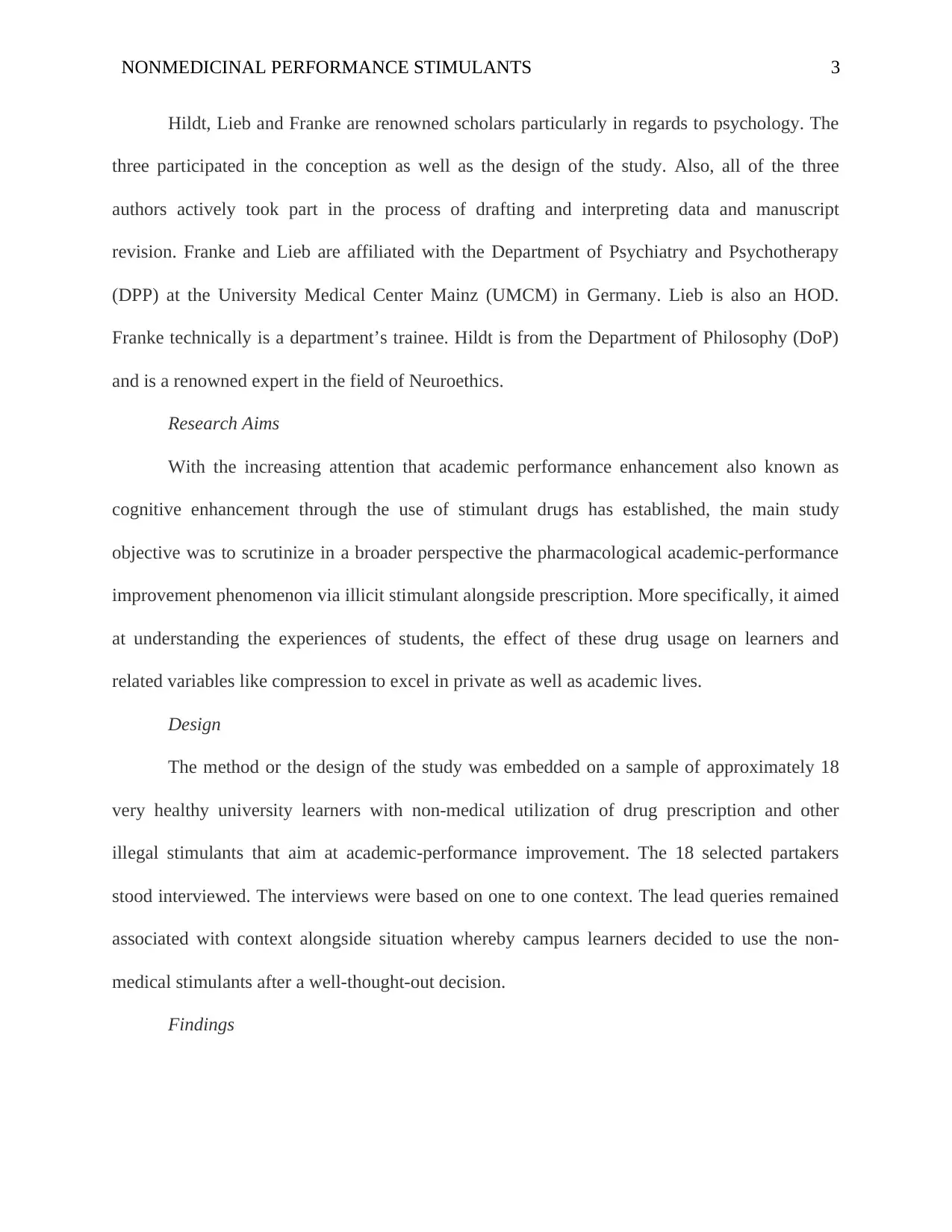
NONMEDICINAL PERFORMANCE STIMULANTS 3
Hildt, Lieb and Franke are renowned scholars particularly in regards to psychology. The
three participated in the conception as well as the design of the study. Also, all of the three
authors actively took part in the process of drafting and interpreting data and manuscript
revision. Franke and Lieb are affiliated with the Department of Psychiatry and Psychotherapy
(DPP) at the University Medical Center Mainz (UMCM) in Germany. Lieb is also an HOD.
Franke technically is a department’s trainee. Hildt is from the Department of Philosophy (DoP)
and is a renowned expert in the field of Neuroethics.
Research Aims
With the increasing attention that academic performance enhancement also known as
cognitive enhancement through the use of stimulant drugs has established, the main study
objective was to scrutinize in a broader perspective the pharmacological academic-performance
improvement phenomenon via illicit stimulant alongside prescription. More specifically, it aimed
at understanding the experiences of students, the effect of these drug usage on learners and
related variables like compression to excel in private as well as academic lives.
Design
The method or the design of the study was embedded on a sample of approximately 18
very healthy university learners with non-medical utilization of drug prescription and other
illegal stimulants that aim at academic-performance improvement. The 18 selected partakers
stood interviewed. The interviews were based on one to one context. The lead queries remained
associated with context alongside situation whereby campus learners decided to use the non-
medical stimulants after a well-thought-out decision.
Findings
Hildt, Lieb and Franke are renowned scholars particularly in regards to psychology. The
three participated in the conception as well as the design of the study. Also, all of the three
authors actively took part in the process of drafting and interpreting data and manuscript
revision. Franke and Lieb are affiliated with the Department of Psychiatry and Psychotherapy
(DPP) at the University Medical Center Mainz (UMCM) in Germany. Lieb is also an HOD.
Franke technically is a department’s trainee. Hildt is from the Department of Philosophy (DoP)
and is a renowned expert in the field of Neuroethics.
Research Aims
With the increasing attention that academic performance enhancement also known as
cognitive enhancement through the use of stimulant drugs has established, the main study
objective was to scrutinize in a broader perspective the pharmacological academic-performance
improvement phenomenon via illicit stimulant alongside prescription. More specifically, it aimed
at understanding the experiences of students, the effect of these drug usage on learners and
related variables like compression to excel in private as well as academic lives.
Design
The method or the design of the study was embedded on a sample of approximately 18
very healthy university learners with non-medical utilization of drug prescription and other
illegal stimulants that aim at academic-performance improvement. The 18 selected partakers
stood interviewed. The interviews were based on one to one context. The lead queries remained
associated with context alongside situation whereby campus learners decided to use the non-
medical stimulants after a well-thought-out decision.
Findings
⊘ This is a preview!⊘
Do you want full access?
Subscribe today to unlock all pages.

Trusted by 1+ million students worldwide
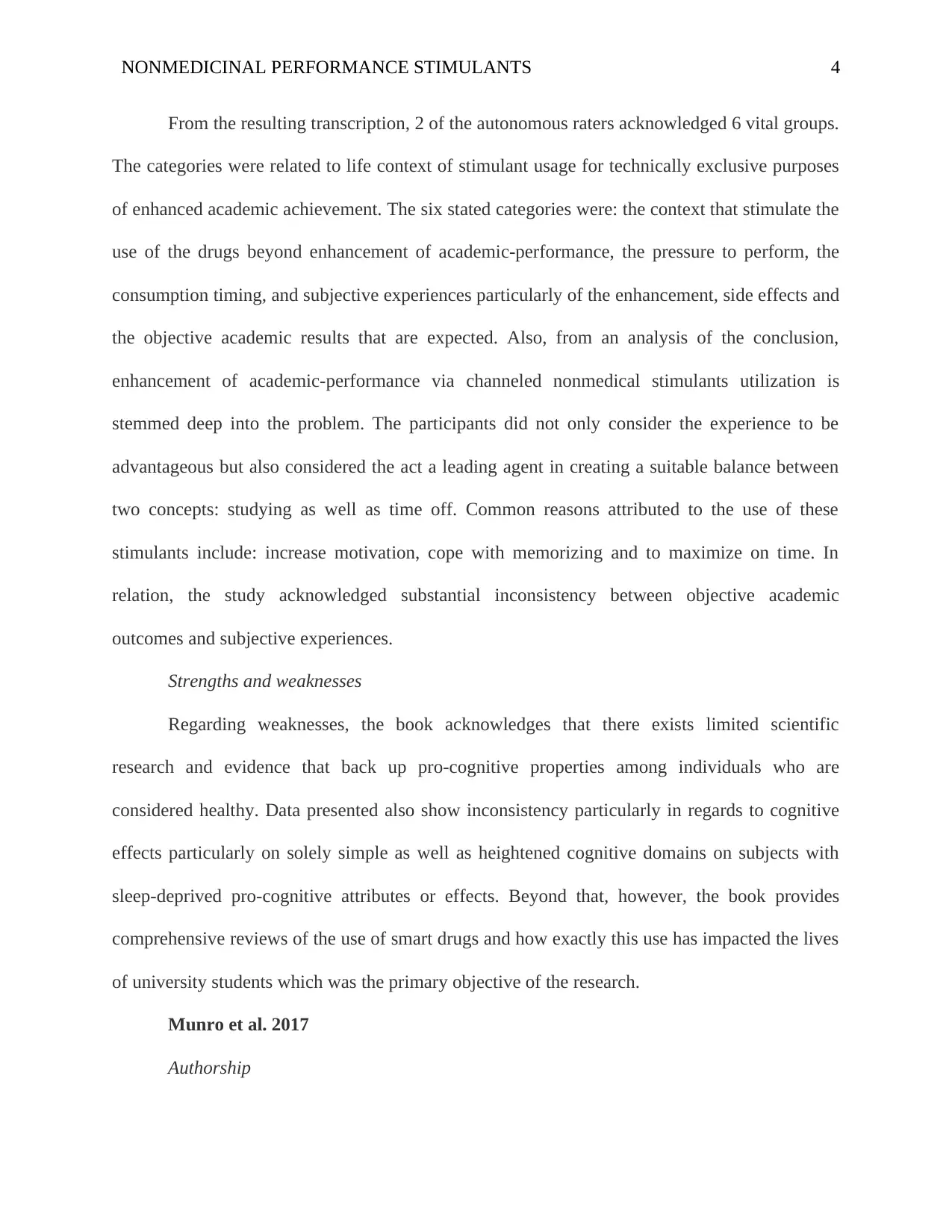
NONMEDICINAL PERFORMANCE STIMULANTS 4
From the resulting transcription, 2 of the autonomous raters acknowledged 6 vital groups.
The categories were related to life context of stimulant usage for technically exclusive purposes
of enhanced academic achievement. The six stated categories were: the context that stimulate the
use of the drugs beyond enhancement of academic-performance, the pressure to perform, the
consumption timing, and subjective experiences particularly of the enhancement, side effects and
the objective academic results that are expected. Also, from an analysis of the conclusion,
enhancement of academic-performance via channeled nonmedical stimulants utilization is
stemmed deep into the problem. The participants did not only consider the experience to be
advantageous but also considered the act a leading agent in creating a suitable balance between
two concepts: studying as well as time off. Common reasons attributed to the use of these
stimulants include: increase motivation, cope with memorizing and to maximize on time. In
relation, the study acknowledged substantial inconsistency between objective academic
outcomes and subjective experiences.
Strengths and weaknesses
Regarding weaknesses, the book acknowledges that there exists limited scientific
research and evidence that back up pro-cognitive properties among individuals who are
considered healthy. Data presented also show inconsistency particularly in regards to cognitive
effects particularly on solely simple as well as heightened cognitive domains on subjects with
sleep-deprived pro-cognitive attributes or effects. Beyond that, however, the book provides
comprehensive reviews of the use of smart drugs and how exactly this use has impacted the lives
of university students which was the primary objective of the research.
Munro et al. 2017
Authorship
From the resulting transcription, 2 of the autonomous raters acknowledged 6 vital groups.
The categories were related to life context of stimulant usage for technically exclusive purposes
of enhanced academic achievement. The six stated categories were: the context that stimulate the
use of the drugs beyond enhancement of academic-performance, the pressure to perform, the
consumption timing, and subjective experiences particularly of the enhancement, side effects and
the objective academic results that are expected. Also, from an analysis of the conclusion,
enhancement of academic-performance via channeled nonmedical stimulants utilization is
stemmed deep into the problem. The participants did not only consider the experience to be
advantageous but also considered the act a leading agent in creating a suitable balance between
two concepts: studying as well as time off. Common reasons attributed to the use of these
stimulants include: increase motivation, cope with memorizing and to maximize on time. In
relation, the study acknowledged substantial inconsistency between objective academic
outcomes and subjective experiences.
Strengths and weaknesses
Regarding weaknesses, the book acknowledges that there exists limited scientific
research and evidence that back up pro-cognitive properties among individuals who are
considered healthy. Data presented also show inconsistency particularly in regards to cognitive
effects particularly on solely simple as well as heightened cognitive domains on subjects with
sleep-deprived pro-cognitive attributes or effects. Beyond that, however, the book provides
comprehensive reviews of the use of smart drugs and how exactly this use has impacted the lives
of university students which was the primary objective of the research.
Munro et al. 2017
Authorship
Paraphrase This Document
Need a fresh take? Get an instant paraphrase of this document with our AI Paraphraser

NONMEDICINAL PERFORMANCE STIMULANTS 5
The book’s multiple authorship gives it a unique sense as well as uniformity of style and
an extensive balance of the contexts. The authorship is also embedded on the substantial
contribution of the acquisition, analysis and the interpretation of the data used in the text.
Additionally, Munro, Weyandt, Marraccini & Oster are all renowned experts in the field of
psychology and social sciences and have technically extensively contributed to the area of study.
Research Aims
The study’s primary objective is the analysis of the concept of nonmedical use of
prescription stimulants (NMUPS) among university students. The study in an in-depth analysis
examines the concept of Executive functioning, self-regulation, cognitive flexibility and goal-
directed behaviors. The study just as the previous analyzed article also aims at understanding the
experiences of students and how these experiences shape decisions especially those embedded on
academic achievements.
Design
Samples were derived from 308 students. The students were from diverse public
universities around the United States. The procedures employed in the research included GPA,
SSQ and BDEFS.
Findings
It was exposed that approximately 18.6% of the sampled students reported the NMUPS
utilization. Partakers with clinical EF-deficits showed advanced NMUPS levels weighed against
those with no deficits in EF. However, it is important to point out that NMUPS did not
extensively influence the association between GPA and EF.
Strengths and weaknesses
The book’s multiple authorship gives it a unique sense as well as uniformity of style and
an extensive balance of the contexts. The authorship is also embedded on the substantial
contribution of the acquisition, analysis and the interpretation of the data used in the text.
Additionally, Munro, Weyandt, Marraccini & Oster are all renowned experts in the field of
psychology and social sciences and have technically extensively contributed to the area of study.
Research Aims
The study’s primary objective is the analysis of the concept of nonmedical use of
prescription stimulants (NMUPS) among university students. The study in an in-depth analysis
examines the concept of Executive functioning, self-regulation, cognitive flexibility and goal-
directed behaviors. The study just as the previous analyzed article also aims at understanding the
experiences of students and how these experiences shape decisions especially those embedded on
academic achievements.
Design
Samples were derived from 308 students. The students were from diverse public
universities around the United States. The procedures employed in the research included GPA,
SSQ and BDEFS.
Findings
It was exposed that approximately 18.6% of the sampled students reported the NMUPS
utilization. Partakers with clinical EF-deficits showed advanced NMUPS levels weighed against
those with no deficits in EF. However, it is important to point out that NMUPS did not
extensively influence the association between GPA and EF.
Strengths and weaknesses
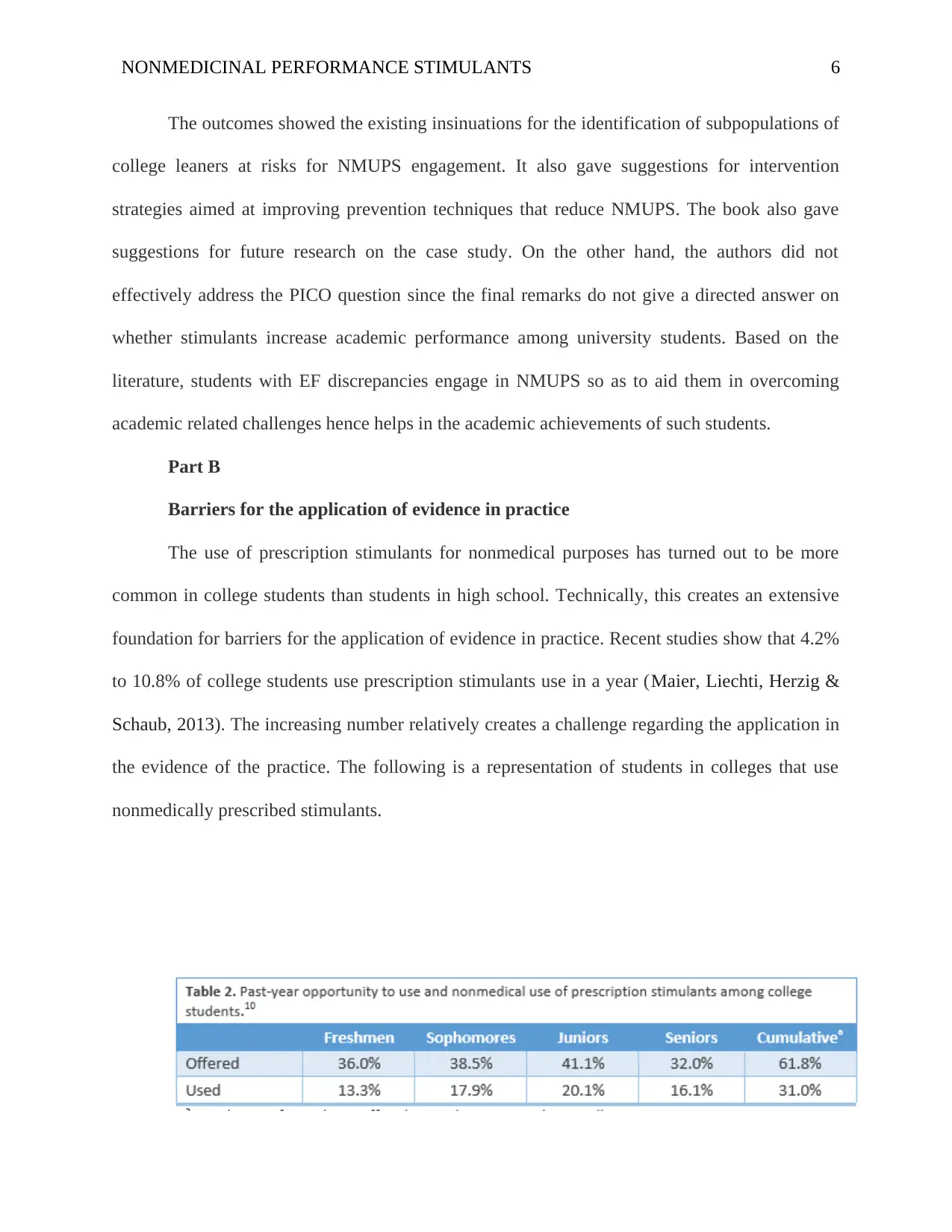
NONMEDICINAL PERFORMANCE STIMULANTS 6
The outcomes showed the existing insinuations for the identification of subpopulations of
college leaners at risks for NMUPS engagement. It also gave suggestions for intervention
strategies aimed at improving prevention techniques that reduce NMUPS. The book also gave
suggestions for future research on the case study. On the other hand, the authors did not
effectively address the PICO question since the final remarks do not give a directed answer on
whether stimulants increase academic performance among university students. Based on the
literature, students with EF discrepancies engage in NMUPS so as to aid them in overcoming
academic related challenges hence helps in the academic achievements of such students.
Part B
Barriers for the application of evidence in practice
The use of prescription stimulants for nonmedical purposes has turned out to be more
common in college students than students in high school. Technically, this creates an extensive
foundation for barriers for the application of evidence in practice. Recent studies show that 4.2%
to 10.8% of college students use prescription stimulants use in a year (Maier, Liechti, Herzig &
Schaub, 2013). The increasing number relatively creates a challenge regarding the application in
the evidence of the practice. The following is a representation of students in colleges that use
nonmedically prescribed stimulants.
The outcomes showed the existing insinuations for the identification of subpopulations of
college leaners at risks for NMUPS engagement. It also gave suggestions for intervention
strategies aimed at improving prevention techniques that reduce NMUPS. The book also gave
suggestions for future research on the case study. On the other hand, the authors did not
effectively address the PICO question since the final remarks do not give a directed answer on
whether stimulants increase academic performance among university students. Based on the
literature, students with EF discrepancies engage in NMUPS so as to aid them in overcoming
academic related challenges hence helps in the academic achievements of such students.
Part B
Barriers for the application of evidence in practice
The use of prescription stimulants for nonmedical purposes has turned out to be more
common in college students than students in high school. Technically, this creates an extensive
foundation for barriers for the application of evidence in practice. Recent studies show that 4.2%
to 10.8% of college students use prescription stimulants use in a year (Maier, Liechti, Herzig &
Schaub, 2013). The increasing number relatively creates a challenge regarding the application in
the evidence of the practice. The following is a representation of students in colleges that use
nonmedically prescribed stimulants.
⊘ This is a preview!⊘
Do you want full access?
Subscribe today to unlock all pages.

Trusted by 1+ million students worldwide
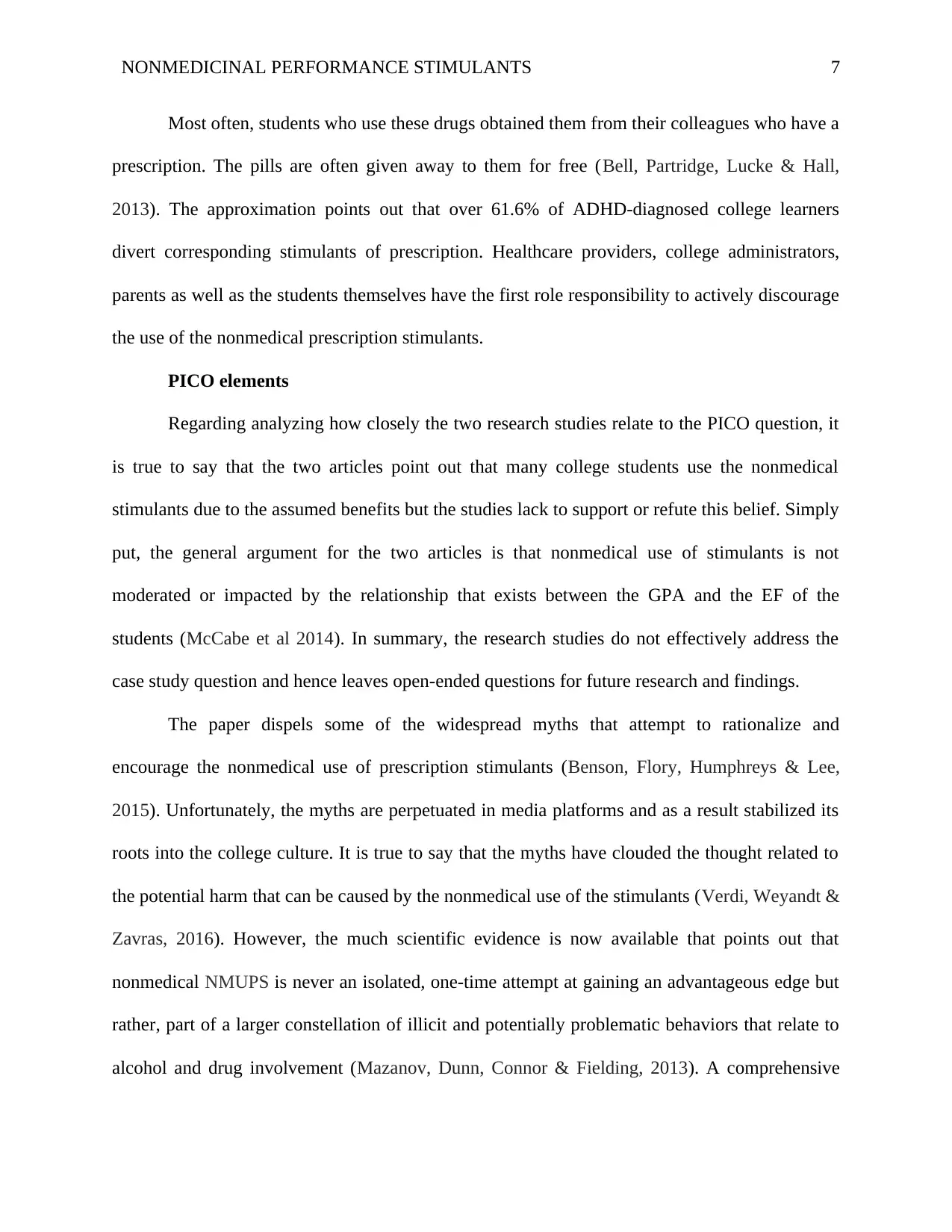
NONMEDICINAL PERFORMANCE STIMULANTS 7
Most often, students who use these drugs obtained them from their colleagues who have a
prescription. The pills are often given away to them for free (Bell, Partridge, Lucke & Hall,
2013). The approximation points out that over 61.6% of ADHD-diagnosed college learners
divert corresponding stimulants of prescription. Healthcare providers, college administrators,
parents as well as the students themselves have the first role responsibility to actively discourage
the use of the nonmedical prescription stimulants.
PICO elements
Regarding analyzing how closely the two research studies relate to the PICO question, it
is true to say that the two articles point out that many college students use the nonmedical
stimulants due to the assumed benefits but the studies lack to support or refute this belief. Simply
put, the general argument for the two articles is that nonmedical use of stimulants is not
moderated or impacted by the relationship that exists between the GPA and the EF of the
students (McCabe et al 2014). In summary, the research studies do not effectively address the
case study question and hence leaves open-ended questions for future research and findings.
The paper dispels some of the widespread myths that attempt to rationalize and
encourage the nonmedical use of prescription stimulants (Benson, Flory, Humphreys & Lee,
2015). Unfortunately, the myths are perpetuated in media platforms and as a result stabilized its
roots into the college culture. It is true to say that the myths have clouded the thought related to
the potential harm that can be caused by the nonmedical use of the stimulants (Verdi, Weyandt &
Zavras, 2016). However, the much scientific evidence is now available that points out that
nonmedical NMUPS is never an isolated, one-time attempt at gaining an advantageous edge but
rather, part of a larger constellation of illicit and potentially problematic behaviors that relate to
alcohol and drug involvement (Mazanov, Dunn, Connor & Fielding, 2013). A comprehensive
Most often, students who use these drugs obtained them from their colleagues who have a
prescription. The pills are often given away to them for free (Bell, Partridge, Lucke & Hall,
2013). The approximation points out that over 61.6% of ADHD-diagnosed college learners
divert corresponding stimulants of prescription. Healthcare providers, college administrators,
parents as well as the students themselves have the first role responsibility to actively discourage
the use of the nonmedical prescription stimulants.
PICO elements
Regarding analyzing how closely the two research studies relate to the PICO question, it
is true to say that the two articles point out that many college students use the nonmedical
stimulants due to the assumed benefits but the studies lack to support or refute this belief. Simply
put, the general argument for the two articles is that nonmedical use of stimulants is not
moderated or impacted by the relationship that exists between the GPA and the EF of the
students (McCabe et al 2014). In summary, the research studies do not effectively address the
case study question and hence leaves open-ended questions for future research and findings.
The paper dispels some of the widespread myths that attempt to rationalize and
encourage the nonmedical use of prescription stimulants (Benson, Flory, Humphreys & Lee,
2015). Unfortunately, the myths are perpetuated in media platforms and as a result stabilized its
roots into the college culture. It is true to say that the myths have clouded the thought related to
the potential harm that can be caused by the nonmedical use of the stimulants (Verdi, Weyandt &
Zavras, 2016). However, the much scientific evidence is now available that points out that
nonmedical NMUPS is never an isolated, one-time attempt at gaining an advantageous edge but
rather, part of a larger constellation of illicit and potentially problematic behaviors that relate to
alcohol and drug involvement (Mazanov, Dunn, Connor & Fielding, 2013). A comprehensive
Paraphrase This Document
Need a fresh take? Get an instant paraphrase of this document with our AI Paraphraser
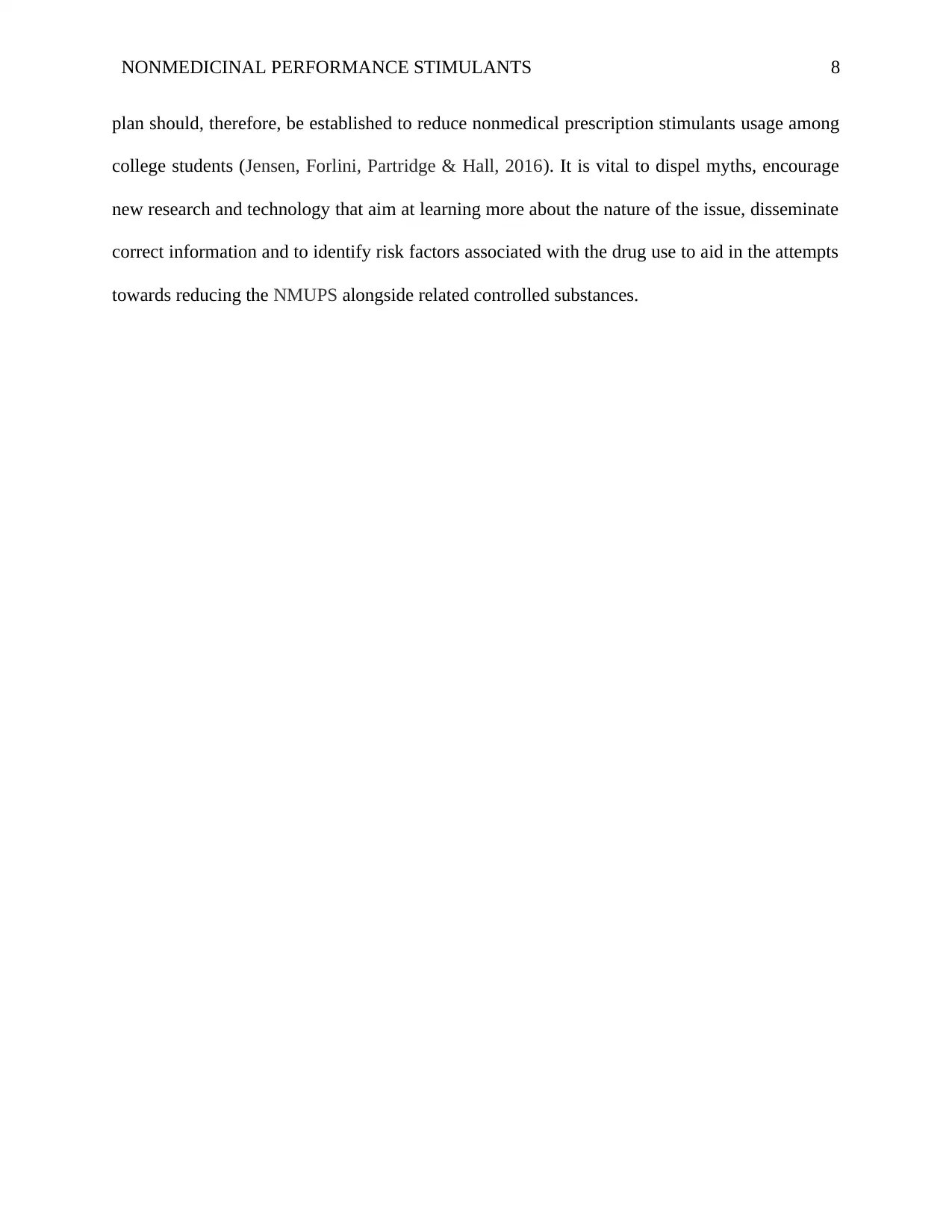
NONMEDICINAL PERFORMANCE STIMULANTS 8
plan should, therefore, be established to reduce nonmedical prescription stimulants usage among
college students (Jensen, Forlini, Partridge & Hall, 2016). It is vital to dispel myths, encourage
new research and technology that aim at learning more about the nature of the issue, disseminate
correct information and to identify risk factors associated with the drug use to aid in the attempts
towards reducing the NMUPS alongside related controlled substances.
plan should, therefore, be established to reduce nonmedical prescription stimulants usage among
college students (Jensen, Forlini, Partridge & Hall, 2016). It is vital to dispel myths, encourage
new research and technology that aim at learning more about the nature of the issue, disseminate
correct information and to identify risk factors associated with the drug use to aid in the attempts
towards reducing the NMUPS alongside related controlled substances.
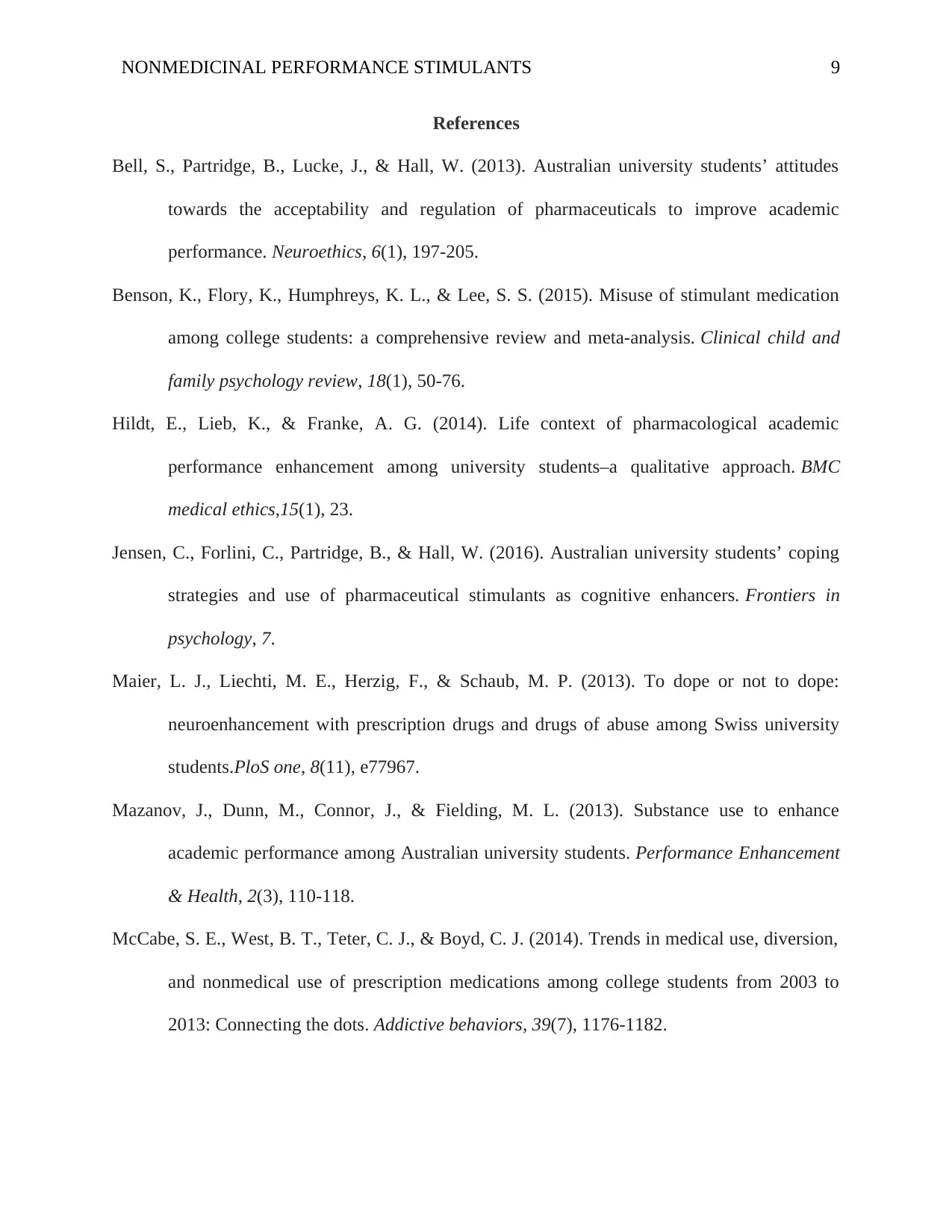
NONMEDICINAL PERFORMANCE STIMULANTS 9
References
Bell, S., Partridge, B., Lucke, J., & Hall, W. (2013). Australian university students’ attitudes
towards the acceptability and regulation of pharmaceuticals to improve academic
performance. Neuroethics, 6(1), 197-205.
Benson, K., Flory, K., Humphreys, K. L., & Lee, S. S. (2015). Misuse of stimulant medication
among college students: a comprehensive review and meta-analysis. Clinical child and
family psychology review, 18(1), 50-76.
Hildt, E., Lieb, K., & Franke, A. G. (2014). Life context of pharmacological academic
performance enhancement among university students–a qualitative approach. BMC
medical ethics,15(1), 23.
Jensen, C., Forlini, C., Partridge, B., & Hall, W. (2016). Australian university students’ coping
strategies and use of pharmaceutical stimulants as cognitive enhancers. Frontiers in
psychology, 7.
Maier, L. J., Liechti, M. E., Herzig, F., & Schaub, M. P. (2013). To dope or not to dope:
neuroenhancement with prescription drugs and drugs of abuse among Swiss university
students.PloS one, 8(11), e77967.
Mazanov, J., Dunn, M., Connor, J., & Fielding, M. L. (2013). Substance use to enhance
academic performance among Australian university students. Performance Enhancement
& Health, 2(3), 110-118.
McCabe, S. E., West, B. T., Teter, C. J., & Boyd, C. J. (2014). Trends in medical use, diversion,
and nonmedical use of prescription medications among college students from 2003 to
2013: Connecting the dots. Addictive behaviors, 39(7), 1176-1182.
References
Bell, S., Partridge, B., Lucke, J., & Hall, W. (2013). Australian university students’ attitudes
towards the acceptability and regulation of pharmaceuticals to improve academic
performance. Neuroethics, 6(1), 197-205.
Benson, K., Flory, K., Humphreys, K. L., & Lee, S. S. (2015). Misuse of stimulant medication
among college students: a comprehensive review and meta-analysis. Clinical child and
family psychology review, 18(1), 50-76.
Hildt, E., Lieb, K., & Franke, A. G. (2014). Life context of pharmacological academic
performance enhancement among university students–a qualitative approach. BMC
medical ethics,15(1), 23.
Jensen, C., Forlini, C., Partridge, B., & Hall, W. (2016). Australian university students’ coping
strategies and use of pharmaceutical stimulants as cognitive enhancers. Frontiers in
psychology, 7.
Maier, L. J., Liechti, M. E., Herzig, F., & Schaub, M. P. (2013). To dope or not to dope:
neuroenhancement with prescription drugs and drugs of abuse among Swiss university
students.PloS one, 8(11), e77967.
Mazanov, J., Dunn, M., Connor, J., & Fielding, M. L. (2013). Substance use to enhance
academic performance among Australian university students. Performance Enhancement
& Health, 2(3), 110-118.
McCabe, S. E., West, B. T., Teter, C. J., & Boyd, C. J. (2014). Trends in medical use, diversion,
and nonmedical use of prescription medications among college students from 2003 to
2013: Connecting the dots. Addictive behaviors, 39(7), 1176-1182.
⊘ This is a preview!⊘
Do you want full access?
Subscribe today to unlock all pages.

Trusted by 1+ million students worldwide
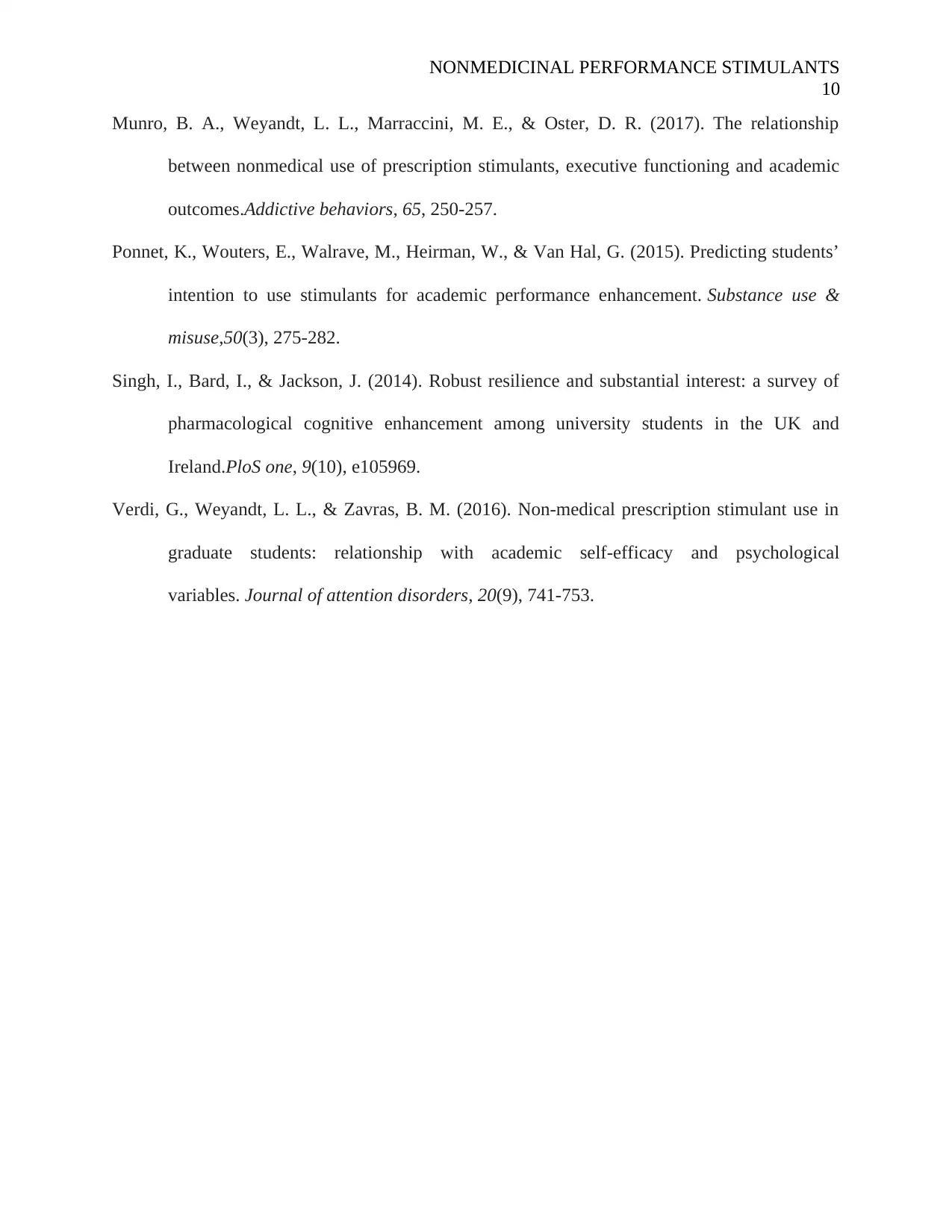
NONMEDICINAL PERFORMANCE STIMULANTS
10
Munro, B. A., Weyandt, L. L., Marraccini, M. E., & Oster, D. R. (2017). The relationship
between nonmedical use of prescription stimulants, executive functioning and academic
outcomes.Addictive behaviors, 65, 250-257.
Ponnet, K., Wouters, E., Walrave, M., Heirman, W., & Van Hal, G. (2015). Predicting students’
intention to use stimulants for academic performance enhancement. Substance use &
misuse,50(3), 275-282.
Singh, I., Bard, I., & Jackson, J. (2014). Robust resilience and substantial interest: a survey of
pharmacological cognitive enhancement among university students in the UK and
Ireland.PloS one, 9(10), e105969.
Verdi, G., Weyandt, L. L., & Zavras, B. M. (2016). Non-medical prescription stimulant use in
graduate students: relationship with academic self-efficacy and psychological
variables. Journal of attention disorders, 20(9), 741-753.
10
Munro, B. A., Weyandt, L. L., Marraccini, M. E., & Oster, D. R. (2017). The relationship
between nonmedical use of prescription stimulants, executive functioning and academic
outcomes.Addictive behaviors, 65, 250-257.
Ponnet, K., Wouters, E., Walrave, M., Heirman, W., & Van Hal, G. (2015). Predicting students’
intention to use stimulants for academic performance enhancement. Substance use &
misuse,50(3), 275-282.
Singh, I., Bard, I., & Jackson, J. (2014). Robust resilience and substantial interest: a survey of
pharmacological cognitive enhancement among university students in the UK and
Ireland.PloS one, 9(10), e105969.
Verdi, G., Weyandt, L. L., & Zavras, B. M. (2016). Non-medical prescription stimulant use in
graduate students: relationship with academic self-efficacy and psychological
variables. Journal of attention disorders, 20(9), 741-753.
1 out of 10
Related Documents
Your All-in-One AI-Powered Toolkit for Academic Success.
+13062052269
info@desklib.com
Available 24*7 on WhatsApp / Email
![[object Object]](/_next/static/media/star-bottom.7253800d.svg)
Unlock your academic potential
Copyright © 2020–2025 A2Z Services. All Rights Reserved. Developed and managed by ZUCOL.





